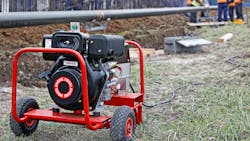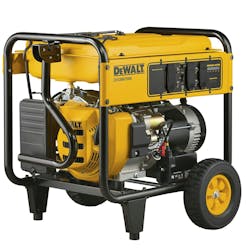Generators used for remote power, or for help powering an office trailer or small building, are too often afterthoughts when it comes to safety.
They’re small, they’re always on hand, and easy to overlook.
It’s a good idea for managers and site superintendents to look at generators as they would any other piece of equipment on the job site. Placement, condition, and other factors should be part of daily considerations.
Plus, in the event of an emergency or outage, the power unit designated as a backup or supplement needs to be ready.
Is propane an option for standby power?
“Not having power when you need it is frustrating, so a generator can provide emergency backup power at a reasonable cost,” says Kris Kiser, president and CEO of the Outdoor Power and Equipment Institute (OPEI). “It’s important to follow all manufacturer’s instructions and never place a generator in a garage or inside your building. It should be a safe distance from the structure—and not near an air intake.
The top 10
OPEI has put together 10 tips for safe generator usage.
- First, take stock of the generator; make sure it’s in good working order before starting and using it. Inspect for any damage, as well.
- Review the directions. Follow all manufacturer’s instructions and read the owner’s manuals. If none were provided, look them up online.
- Install a battery-operated carbon monoxide detector in the building.
- Have the right fuel on hand. Use the type of fuel recommended by the generator manufacturer. Note that it’s illegal to use any fuel with more than 10% ethanol in outdoor power equipment.
- Ensure portable generators have plenty of ventilation. They should never be used in an enclosed area or placed inside a building, even if windows and doors are open. Be sure the generator is away from any vents, windows or doors that could let carbon monoxide to seep indoors.
- Keep the generator dry. Cover and vent it.
- When adding fuel, make sure the generator is cool. Before refueling, turn it off and let it cool down.
- Plug in safely. If there isn’t a transfer switch, it’s possible to use the outlets on the generator. If using any extension cords, make sure they’re heavy duty and rated for outdoor use. Check that the cord isn’t damaged and all the prongs are intact.
- Install a transfer switch. A transfer switch connects the generator to the circuit panel for powering hardwired appliances. Most transfer switches display wattage usage levels to help avoid overload.
- Do not use the generator to “backfeed” power into a building’s electrical system. That means do not plug it into a conventional wall outlet. Remember that backfeeding bypasses built-in circuit protection devices. This may cause damage or an electrical fire.
Tips for lifting and moving
It’s also important to be safe in lifting and moving generators. Caterpillar has some handy tips from when Cat Home and Outdoor Power offered a line of portable units.
Ensure that any lifting device is rated for lifting more than the weight of the generator itself. (Most portable units are around 500 pounds.) Inspect the device before each use to ensure it is functioning properly and that its cable/rope is not compromised.
Always use a lifting device as intended by its manufacturer and never use a malfunctioning or damaged lifting device.
For safety, always lift from a flat, horizontal surface and from directly above the generator. Do not lift the portable generator from an angle. Exercise extreme caution at all times, especially when the portable generator is suspended.
Be aware that the lifting device cable/rope could snap so stand as far from the lifting device as possible and do not stand or pass directly under or within a 10-foot radius of a suspended generator.
Beware of a swinging load. Manage a swinging load by using a guide or tether line; do not attempt to stop it with your body.
About the Author
Frank Raczon
Raczon’s writing career spans nearly 25 years, including magazine publishing and public relations work with some of the industry’s major equipment manufacturers. He has won numerous awards in his career, including nods from the Construction Writers Association, the Association of Equipment Manufacturers, and BtoB magazine. He is responsible for the magazine's Buying Files.


